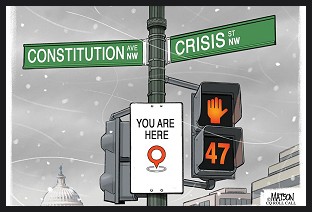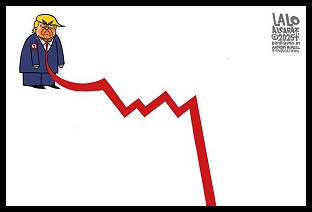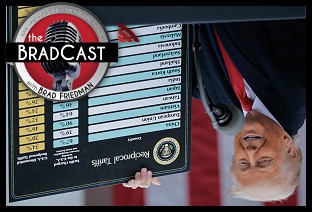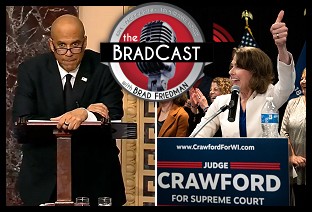The various voting issue movements have done it again, like they have for 40 years. Made things worse by personality cult mentality and vague notions of the law and the facts. Another bill made worse.
The electronic voting machine (EVM) watchdogs twenty years ago were saying what was said before the committee recently (1988 Article).
You can shock the hell out of the EVM audience with these quotes from a 1988 official report:
4.13 Summary Of Problem Types
4.13.1 Insufficient Pre-election Testing
4.13.2 Failure to Implement an Adequate Audit Trail
4.13.3 Failure to Provide for a Partial Manual Recount
4.13.4 Inadequate Ballots or Ballot-Reader Operation
4.13.5 Inadequate Security and Management Control
4.13.6 Inadequate Contingency Planning
4.13.7 Inadequate System Acceptance Procedures
...
Concern had been heightened by a series of articles published in the summer of 1985 in the New York Times. The articles cited statements by two computer experts reporting that a computer program widely used for vote-tallying was vulnerable to tampering. Several elections were identified in which losing candidates claimed that it would be possible to fraudulently alter the computer programs that were used in their contests.
(NIST Report 1988, bold added).
No one mentioned that even twenty years is enough to have more than "suggested rules" which are admittedly inadequate ... which election war lords are ignoring anyway.
And who asked why one person certifies the machines no matter how many ITA companies claim to do the certification? Or who sets the standards of the lone ranger doing the testing (The Lone Tester)?
It appears that once again the voting rights movement related to the EVM world has noised bratty concerns to help congress fail and Diebold win again?
The only question I think remains is whether the EVM movement's muck up will be for the last time or not. I seriously doubt that it will be.
The reference Dredd has brought forward is indeed a - maybe THE - classic, by Roy Saltman.
There was another one worth remembering: Ronnie Dugger, The New Yorker, "Annals of Democracy: Counting Votes" 11/7/88.
Here'e the link [Prof. Neumann archived it on his own site]:
http://www.csl.sri.com/users/neumann/dugger.html
It's really great. Here are some samples:
Dugger met Dunn and Neumann at various points. Dunn: "There are at least a half-dozen places, maybe a few less, where you could lay in a Trojan horse in that source code - lay in routines to do whatever you wanted to in an election. There's code in that system that shouldn't be there, is not being used, is worthless to the operation of the system. It can be replaced with anything you want it to be."
Had Nunn found a trapdoor; that is, a place in a program where one can break down its security system and emerge undetected deep inside the program?
"Yes. There is one."
And had he found "wait loops" in the program which conceivably could control outcomes, or "Christmas trees" - Nunn's term for surprise packages [also called "easter eggs"]?
"They're all there. There are wait loops there. There are routines that are not documented in the manual and, from every way I can determine, do not work."
As we talked, Nunn got up from the couch, where he had been sitting, walked to his desk, and sat down at the Macintosh... "I've come up with an idea." After about ten minutes, during which we went on with the discussion, he called me over to the keyboard and invited me to add on the computer any numbers that came into my head. I added eight and thirteen, then two multi-digit figures; the sums printed on the screen were correct. "Now," he said from the couch, to which he had returned, "add two and two." On the off-the-shelf program of this standard brand computer two and two added up to five. In ten minutes, before my eyes, Nunn had made a Trojan horse for me. He printed the five-step program out and gave it to me. I still have it:
10 input x
20 input y
30 if x = 2 then x = 3
40 print "The sum of x + y is", x+y
50 go to 10
Line 30 is the Trojan horse inserted into the program that makes two and two five. "I've told it every time it sees the number two, replace it with a three," Nunn said.
...
Speaking in his office at S.R.I., amid papers stacked and scattered about on his desk and the floor and a chair nearby, Neumann went on,"Even if you can look at the source code, you can't guarantee that there's not a Trojan horse embedded somewhere in the code. Any self-respecting system programmer can hack the innards of the system to defeat encryption techniques or any password protection, or anything like that. All this stuff is trivial to break, for the most part. In most computer systems out there, it is child's play.
Given the fact that the underlying systems are so penetrable, it is relatively easy to fudge data - for example, to start out with three thousand votes for one guy and zero for the other before the counting even starts, even though the counter shows zero. Essentially a Trojan horse in the coding. I can do it in the operating system. I can do it in the application program. Or I can do it in the compiler. I can rig it so that all test decks work perfectly well. I program it so that, after the test is run, at, say, six-fifty-five in the evening, it simply adds thousands of votes. It would never show up. He added that having a computer count a set portion of one candidate's votes as if they had been cast for his or her opponent would be "utterly trivial to do."
As for stealing a Presidential election, Neumann said, "I would put in a whole variety of techniques. I wouldn't just rely on one. You might use a different technique in each state, for example. You could trigger it so that you didn't do anything wrong if everything was going well, and if your candidate was losing you simply add votes-and you have to subtract, too. You have to make all the consistency checks satisfy. That's relatively easy to do."
Neumann exclaimed, "The possibilities are endless!" He seemed to be enjoying them, but then drew back. "I think the possibilities for rigging elections with computers are enormous. I'm not going to say it's ever been done. The point here is it's in the hands of one very skilled programmer or somebody who understands the system."
===
It goes on and on; I always hate to leave it...
Oddly enough, one person Dugger met was Shamos, who also obliged by showing how to subvert a system...
Dredd is right; it's been there in plain sight all these these years and if you mention it you're a tinfoil hat type...
ARGH!
HCPB
 An article in Arstechnica correctly points out that the Lofgren amendment to HR-811:
An article in Arstechnica correctly points out that the Lofgren amendment to HR-811:

 Nation's Largest Broadcaster Mandates News Outlets Hoax Viewers to Help Gut FCC Rules: 'BradCast' 4/23/25
Nation's Largest Broadcaster Mandates News Outlets Hoax Viewers to Help Gut FCC Rules: 'BradCast' 4/23/25 Trump's FCC on Precipice of Ending All Limits on Corporate Control of Local TV Stations
Trump's FCC on Precipice of Ending All Limits on Corporate Control of Local TV Stations GOP Earth Day 2025 Hypocrisies and Dilemmas: 'BradCast' 4/22/25
GOP Earth Day 2025 Hypocrisies and Dilemmas: 'BradCast' 4/22/25 'Green News Report' 4/22/25
'Green News Report' 4/22/25
 Pope Francis Dies,
Pope Francis Dies, Sunday
Sunday  Sunday 'Zero Day' Toons
Sunday 'Zero Day' Toons Soc. Sec. Expert Warns DOGE Hastening Collapse, Privati-zation: 'BradCast' 4/10/2025
Soc. Sec. Expert Warns DOGE Hastening Collapse, Privati-zation: 'BradCast' 4/10/2025 'Green News Report' 4/10/25
'Green News Report' 4/10/25 Trump Blinks, Chaos Reigns, Markets Spike as Many Tariffs Remain Despite 90-Day 'Pause': 'BradCast' 4/9/25
Trump Blinks, Chaos Reigns, Markets Spike as Many Tariffs Remain Despite 90-Day 'Pause': 'BradCast' 4/9/25 SCOTUS Deportation Ruling Grimmer Than First Appears: 'BradCast' 4/8/25
SCOTUS Deportation Ruling Grimmer Than First Appears: 'BradCast' 4/8/25 'Green News Report' 4/8/25
'Green News Report' 4/8/25 Cliff Diving with Donald: 'BradCast' 4/7/25
Cliff Diving with Donald: 'BradCast' 4/7/25 Sunday 'Don't Look Down' Toons
Sunday 'Don't Look Down' Toons 'Green News Report' 4/3/25
'Green News Report' 4/3/25 'Mob Boss' Trump's Trade Sanctions Tank U.S., World Markets: 'BradCast' 4/3/25
'Mob Boss' Trump's Trade Sanctions Tank U.S., World Markets: 'BradCast' 4/3/25 Crawford Landslide in WI; Booker Makes History in U.S. Senate: 'BradCast' 4/2/25
Crawford Landslide in WI; Booker Makes History in U.S. Senate: 'BradCast' 4/2/25 Judge Ends Challenge to GA's Unverifiable, Insecure Vote System: 'BradCast' 4/1/25
Judge Ends Challenge to GA's Unverifiable, Insecure Vote System: 'BradCast' 4/1/25 Bad Court, Election News for Trump is Good News for U.S.: 'BradCast' 3/31
Bad Court, Election News for Trump is Good News for U.S.: 'BradCast' 3/31 Vets Push Back at Plan to Slash Health Care, 80K V.A. Jobs: 'BradCast' 3/27/25
Vets Push Back at Plan to Slash Health Care, 80K V.A. Jobs: 'BradCast' 3/27/25 Signal Scandal Worsens for Trump, GOP; Big Dem Election Wins in PA: 'BradCast' 3/26
Signal Scandal Worsens for Trump, GOP; Big Dem Election Wins in PA: 'BradCast' 3/26 'Emptywheel': Trump NatSec Team Should 'Resign in Disgrace': 'BradCast' 3/25/25
'Emptywheel': Trump NatSec Team Should 'Resign in Disgrace': 'BradCast' 3/25/25 USPS 'Belongs to the People, Not the Billionaires': 'BradCast' 3/24/25
USPS 'Belongs to the People, Not the Billionaires': 'BradCast' 3/24/25
 VA GOP VOTER REG FRAUDSTER OFF HOOK
VA GOP VOTER REG FRAUDSTER OFF HOOK Criminal GOP Voter Registration Fraud Probe Expanding in VA
Criminal GOP Voter Registration Fraud Probe Expanding in VA DOJ PROBE SOUGHT AFTER VA ARREST
DOJ PROBE SOUGHT AFTER VA ARREST Arrest in VA: GOP Voter Reg Scandal Widens
Arrest in VA: GOP Voter Reg Scandal Widens ALL TOGETHER: ROVE, SPROUL, KOCHS, RNC
ALL TOGETHER: ROVE, SPROUL, KOCHS, RNC LATimes: RNC's 'Fired' Sproul Working for Repubs in 'as Many as 30 States'
LATimes: RNC's 'Fired' Sproul Working for Repubs in 'as Many as 30 States' 'Fired' Sproul Group 'Cloned', Still Working for Republicans in At Least 10 States
'Fired' Sproul Group 'Cloned', Still Working for Republicans in At Least 10 States FINALLY: FOX ON GOP REG FRAUD SCANDAL
FINALLY: FOX ON GOP REG FRAUD SCANDAL COLORADO FOLLOWS FLORIDA WITH GOP CRIMINAL INVESTIGATION
COLORADO FOLLOWS FLORIDA WITH GOP CRIMINAL INVESTIGATION CRIMINAL PROBE LAUNCHED INTO GOP VOTER REGISTRATION FRAUD SCANDAL IN FL
CRIMINAL PROBE LAUNCHED INTO GOP VOTER REGISTRATION FRAUD SCANDAL IN FL Brad Breaks PA Photo ID & GOP Registration Fraud Scandal News on Hartmann TV
Brad Breaks PA Photo ID & GOP Registration Fraud Scandal News on Hartmann TV  CAUGHT ON TAPE: COORDINATED NATIONWIDE GOP VOTER REG SCAM
CAUGHT ON TAPE: COORDINATED NATIONWIDE GOP VOTER REG SCAM CRIMINAL ELECTION FRAUD COMPLAINT FILED AGAINST GOP 'FRAUD' FIRM
CRIMINAL ELECTION FRAUD COMPLAINT FILED AGAINST GOP 'FRAUD' FIRM RICK SCOTT GETS ROLLED IN GOP REGISTRATION FRAUD SCANDAL
RICK SCOTT GETS ROLLED IN GOP REGISTRATION FRAUD SCANDAL VIDEO: Brad Breaks GOP Reg Fraud Scandal on Hartmann TV
VIDEO: Brad Breaks GOP Reg Fraud Scandal on Hartmann TV RNC FIRES NATIONAL VOTER REGISTRATION FIRM FOR FRAUD
RNC FIRES NATIONAL VOTER REGISTRATION FIRM FOR FRAUD EXCLUSIVE: Intvw w/ FL Official Who First Discovered GOP Reg Fraud
EXCLUSIVE: Intvw w/ FL Official Who First Discovered GOP Reg Fraud GOP REGISTRATION FRAUD FOUND IN FL
GOP REGISTRATION FRAUD FOUND IN FL


































